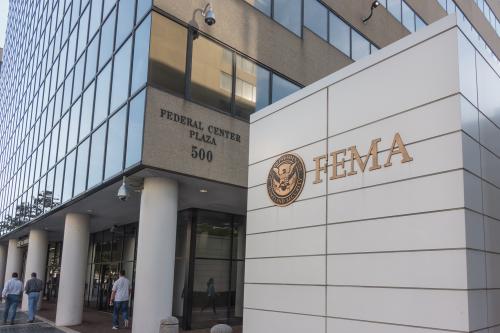People choose where to live based on a few underlying factors: proximity to where they work, preferred amenities like school quality or climate, and connections to social networks of family and friends. But the pandemic may have fundamentally changed some of these factors—loosening the need to live within daily commuting distance of workplaces and increasing preference for larger homes to accommodate telework. According to prevailing media narratives, the pandemic has “supercharged” suburbanization rates and even hastened the death of U.S. cities.
Homebuilders responded to this demand shift in 2020 by increasing single-family home construction in low-density areas, such as small metro area suburbs and small towns. The average size of new single-family homes also increased in 2021, following a period of decline between 2016 and 2020.
Yet there is still widespread uncertainty around what is actually happening during the pandemic—and our post-pandemic future. One point is clear: Regions remain highly complex. And whatever short-term changes may be happening, planners and other regional leaders cannot lose sight of long-term needs: increasing the supply of smaller, moderately priced homes in compact, climate-friendly development patterns. Leaders can’t just plan for the current moment; they need to plan for a more resilient future.
Did the pandemic boost demand for suburban living—or just continue long-term trends?
Looking at data on county-level population changes during the first year of the pandemic shows some evidence of flight from the densest, most expensive cities and major metro areas. But this largely continues pre-pandemic trends. Between July 1, 2020 and July 1, 2021, many core urban counties (those home to the largest city within a metro area) continued to experience greater population losses than their neighboring suburban counties.
To illustrate this, Figure 1 shows the population change across three pairs of urban and suburban counties: New York County (Manhattan) and Nassau County (suburban Long Island); Michigan’s Wayne County (home to Detroit) and suburban Oakland County; and Texas’ Dallas County and suburban Collin County. In all three cases, the core urban counties lost population more rapidly between 2020 and 2021 compared to their neighboring suburban counties.
 But more rapid population growth—or lower population decline—among suburban counties during the pandemic is not new.
But more rapid population growth—or lower population decline—among suburban counties during the pandemic is not new.
As Figure 2 shows, counties that saw higher population growth from 2010 to 2020 also saw more growth (or at least smaller population losses) from 2020 to 2021. Suburban Collin County far outpaced growth in Dallas County (and indeed, most large U.S. counties) during the 2010 to 2020 period. The obvious outlier is New York County (Manhattan), which suffered huge population losses during the first year of the pandemic, after growing during the second half of the previous decade. Not coincidentally, New York is also among the most expensive housing markets in the U.S. and has a large number of jobs that can be done remotely.
 Also notable: While the pandemic may have encouraged some people to flee expensive housing markets, it does not appear to be attracting residents to low-cost urban areas that have seen long-term population decline, like Detroit. This is consistent with research showing that urban amenities such as restaurants, museums, and entertainment venues are important factors in attracting and retaining residents.
Also notable: While the pandemic may have encouraged some people to flee expensive housing markets, it does not appear to be attracting residents to low-cost urban areas that have seen long-term population decline, like Detroit. This is consistent with research showing that urban amenities such as restaurants, museums, and entertainment venues are important factors in attracting and retaining residents.
But more likely than not, these recent trends may only represent a temporary blip, so it’s important to contextualize them as continuations of longer-term trends. Change-of-address data from the U.S. Postal Service shows that while there were some pandemic-related spikes during March, April, and December 2020 concentrated among individual and temporary moves, as of mid-2021, these trends have normalized to where they were before the pandemic. And data from Apartment List’s national rent report shows that while increases in rent prices dipped from March to December 2020, rent price growth since January 2021 has spiked 17.8%, and by April 2021, had fully rebounded in nearly all urban, suburban, and exurban markets—at least equal to pre-Covid levels, if not higher.
These early indicators suggest that the pandemic caused massive disruptions in the short term, mostly due to its sudden nature and the inability of regional leaders to respond to such sharp changes in housing demand. Due to the inflexible nature of our land use plans—especially in cities and inner-ring suburbs—we’ve been building homes in the wrong places and in the wrong ways. As demand for bigger homes spiked, we saw planners concentrate construction in places where they can build most quickly (exurbs) without prioritizing neighborhood-serving retail, density, and proximity in neighborhood design.
Employers, workers, researchers, and policymakers don’t yet know whether the expanded telework/hybrid office model will last, and for how many workers. This uncertainty also deters making long-term investments, such as updating land use plans and building infrastructure.
Lessons for policymakers: Keep long-term goals in mind and increase short-term flexibility
Whether the reaction to the pandemic is a short-term blip or longer-term pattern, it has not reduced our collective need for greater resilience—supporting our ability to live in safe, affordable, and climate-friendly communities. That means having smaller, more affordable housing, which allows workers at all income levels to live close to jobs and amenities. It also means having safer, more reliable, and more affordable transportation options. And it means striving for reduced greenhouse gas emissions and greater climate certainty and adaptation.
Regional leaders shouldn’t overreact to short-term headlines about a supposed suburban “gold rush.” They need to take a step back and recognize the uncertainty and complexity surrounding them—including the need to better analyze and assess their region’s evolving concerns. Pursuing this type of approach is tough, because the signals are conflicting in different parts of the country and the long-run impacts of the pandemic aren’t yet known.
In light of these unknowns, post-pandemic planning should focus on baking in more flexibility and best practices into our land use plans to prepare us for both potential future spikes in housing demand and the general long-term trend of increasing suburban and exurban population growth. This means embedding suburban retrofits and urbanization into suburban planning, which includes more multifamily housing near transit, mixed-use town centers, and investing in suburban public transit to job centers to promote equitable, higher-density, transit-oriented development. The Mosaic District in Fairfax County, Va. is an example: a 10-year suburban retrofit project that replaced single-use commercial areas with higher-density, mixed-use, transit-oriented centers.
Ultimately, even if pandemic-related trends continue, incorporating more flexibility and best practices into our land use planning is a must for planners and other regional leaders to navigate our post-pandemic future.





Commentary
Pandemic-fueled suburban growth doesn’t mean we should abandon climate resiliency
April 12, 2022